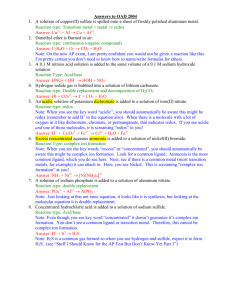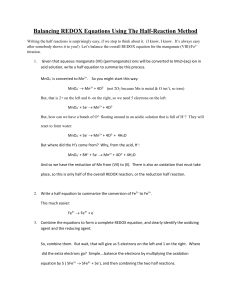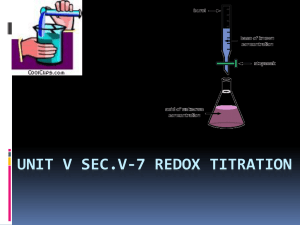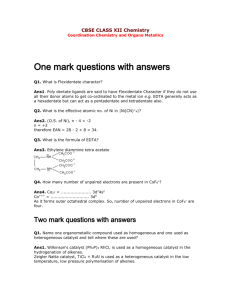Topic 3 – Chemical Structure and Bonding
advertisement
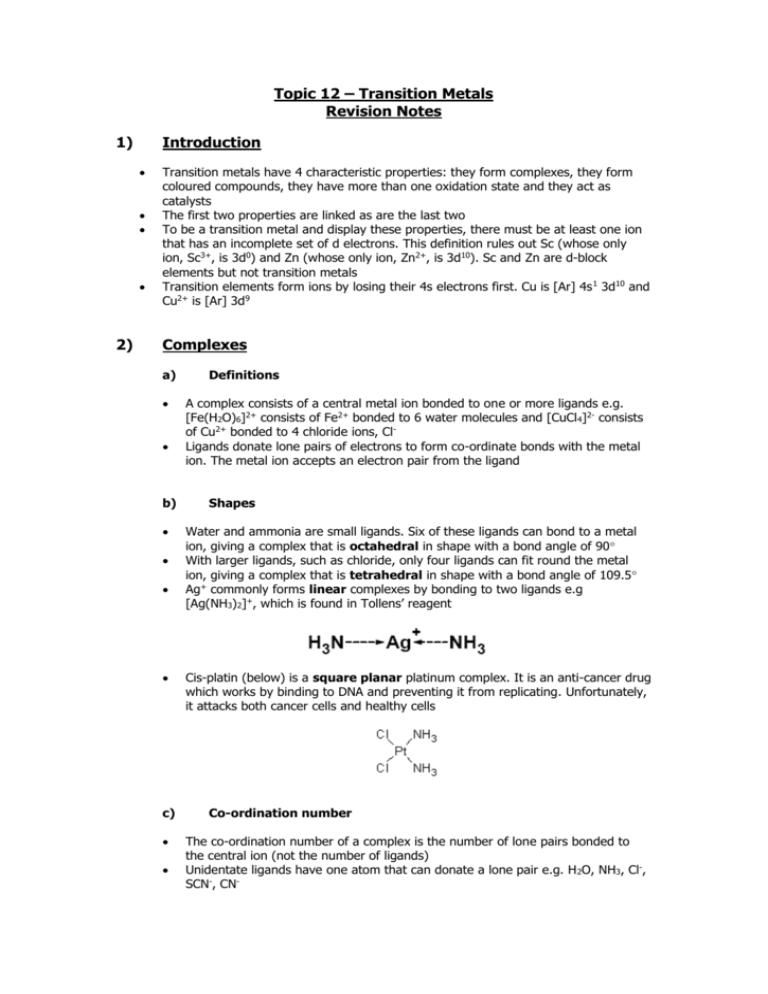
Topic 12 – Transition Metals Revision Notes 1) Introduction 2) Transition metals have 4 characteristic properties: they form complexes, they form coloured compounds, they have more than one oxidation state and they act as catalysts The first two properties are linked as are the last two To be a transition metal and display these properties, there must be at least one ion that has an incomplete set of d electrons. This definition rules out Sc (whose only ion, Sc3+, is 3d0) and Zn (whose only ion, Zn2+, is 3d10). Sc and Zn are d-block elements but not transition metals Transition elements form ions by losing their 4s electrons first. Cu is [Ar] 4s 1 3d10 and Cu2+ is [Ar] 3d9 Complexes a) b) c) Definitions A complex consists of a central metal ion bonded to one or more ligands e.g. [Fe(H2O)6]2+ consists of Fe2+ bonded to 6 water molecules and [CuCl 4]2- consists of Cu2+ bonded to 4 chloride ions, ClLigands donate lone pairs of electrons to form co-ordinate bonds with the metal ion. The metal ion accepts an electron pair from the ligand Shapes Water and ammonia are small ligands. Six of these ligands can bond to a metal ion, giving a complex that is octahedral in shape with a bond angle of 90 With larger ligands, such as chloride, only four ligands can fit round the metal ion, giving a complex that is tetrahedral in shape with a bond angle of 109.5 Ag+ commonly forms linear complexes by bonding to two ligands e.g [Ag(NH3)2]+, which is found in Tollens’ reagent Cis-platin (below) is a square planar platinum complex. It is an anti-cancer drug which works by binding to DNA and preventing it from replicating. Unfortunately, it attacks both cancer cells and healthy cells Co-ordination number The co-ordination number of a complex is the number of lone pairs bonded to the central ion (not the number of ligands) Unidentate ligands have one atom that can donate a lone pair e.g. H 2O, NH3, Cl-, SCN-, CN- Bidentate ligands have two atoms that can donate a lone pair e.g. 1,2diaminoethane, H2NCH2CH2NH2, which bonds through the lone pairs on the nitrogen atoms and ethanedioate, C2O42-, which bonds through lone pairs on the O-‘s Multidentate ligands have more than two atoms that can donate a lone pair e.g. porphyrin is tetradentate and EDTA4- is hexadentate [Co(NH3)6]2+ Co-ordination number 6 Octahedral shape [Pt(NH3)2Cl2] Co-ordination number 4 Square planar shape d) Co-ordination number Porphyrin is a planar tetradentate ligand Source: http://en.wikipedia.org/wiki/Porphyrin [Co(H2NCH2CH2NH2)3]2+ co-ordination number 6 (not 3) octahedral shape [CoCl4]2co-ordination number 4 tetrahedral shape 3) Colour 4) When the N atoms in porphyrin forms four co-ordinate bonds with Fe2+, the resulting complex is called haem The iron achieves a co-ordination number of 6 by bonding to the protein globin and to either an oxygen or water molecule. If the sixth bond is to oxygen, the complex produced is oxyhaemoglobin. If the sixth bond is to water the complex is deoxyhaemoglobin. The oxygen bonds only weakly to the Fe2+. Carbon monoxide forms a much stronger bond with Fe2+ and is therefore poisonous because it reduces the oxygen carrying capacity of the blood To be coloured a transition metal ion must have a partially filled d-sub level i.e. between 1 and 9 d electrons. Ions with an empty d-sub level (3d0) or a full d-sub level (3d10) will not be coloured. In a gaseous ion, such as Ti3+(g), all 5 d orbitals have the same energy. When surrounded by ligands (e.g. [Ti(H2O)6]3+), the d orbitals split into 2 sets (one of higher energy and one of lower energy) Electrons can be promoted from the lower energy set to the higher energy set by absorbing visible light (yellow-green is absorbed in the case of [Ti(H2O)6]3+) Coloured light is transmitted (violet in the case of [Ti(H2O)6]3+) The colour of light absorbed depends on the energy gap between the two sets of orbitals The energy gap depends on the oxidation state of the metal, the co-ordination number and the identity of the ligand. Changing any of these can change the colour of the complex The relationship between the energy gap, E, and the frequency of the visible light, , is given by E = h, where h is Planck’s constant Visible light spectrometry/colorimetry Visible light spectrometry is a technique for measuring how much radiation is absorbed by a coloured solution across a range of frequencies A colorimeter is a simplified machine that measures absorption at a particular frequency (rather than across a spectrum) Colorimetry can be used to determine the concentration of a transition metal ion solution because the amount of radiation absorbed is proportional to the concentration of the solution being tested As some transition metal solutions are pale in colour, a suitable ligand may be added to intensify the colour e.g. thiocyanate ions, SCN-, can be added to Fe3+(aq) [Fe(H2O)6]3+ + SCN- [Fe(H2O)5SCN]2+ + H2O Pale violet intense blood-red 5) A calibration graph is plotted of the absorption by solutions of known concentration If the absorption of a solution of unknown concentration is measured, its concentration can be read off the graph Redox titrations As with acid-base reactions in Module 1, redox reactions can be used to determine unknown concentrations etc. The method involves three steps: Step 1 Step 2 Step 3 Calculate moles using concentration x volume/1000 Use the redox equation to calculate moles of other chemical Use moles from step 2 to calculate unknown concentration etc Example – A student takes 25.0 cm3 of aqueous hydrogen peroxide, H2O2, and places this in a conical flask and then adds sulphuric acid to acidify the hydrogen peroxide. The student titrates this sample of acidified hydrogen peroxide against a solution containing 0.0200 mol dm-3 MnO4-(aq) ions. For complete reaction with the acidified hydrogen peroxide, the student used 17.5 cm 3 of this solution containing MnO4-(aq) ions. Calculate the concentration, in mol dm-3, of the aqueous hydrogen peroxide. 2 mol MnO4- reacts with 5 mol H2O2. Step 1 moles MnO4Step 2 moles H2O2 Step 3 conc H2O2 = = = = = = = = conc x vol/1000 0.02 x 17.5/1000 3.5 x 10-4 3.5 x 10-4 x 5/2 8.75 x 10-4 moles/volume 8.75 x 10-4/25 x 10-3 0.035 mol dm-3 Source: OCR paper January 2004 a) Iron(II)/manganate(VII) titrations MnO4- oxidises Fe2+ to Fe3+ and is reduced to Mn2+ End-point is colourless to pink Excess H+ is needed to ensure that all the MnO 4- is converted to Mn2+ 6) The H+ is provided by dilute H2SO4 which is a strong acid that will not interfere with the desired redox reaction Weak acids, such as ethanoic, cannot be used as they do not provide enough H + HCl would be oxidised by MnO4HNO3 and concentrated H2SO4 are oxidising agents themselves Heterogeneous catalysts A heterogeneous catalyst is in a different phase (physical state) from the reactants. It is usually a solid catalysing a reaction between gases e.g. Fe in Haber process The mechanism for heterogeneous catalysis involves three steps: o Adsorption of the reactants at active sites on the surface of the catalyst o Bonds in the reactants are weakened (allowing reaction to takes place) o Desorption of products from the surface of the catalyst Bonding to the surface of the catalyst must be strong enough to weaken bonds and allow reaction to take place but weak enough to allow desorption after the reaction The catalysts with the right amount of adsorption are in the centre of the d-block i.e. Ni, Pt, Pd and Rh Tungsten, W, on the left of the d-block adsorbs too strongly which means that products will not be desorbed and active sites will be blocked Silver, Ag, on the right adsorbs too weakly so reactants are not held for long enough for bonds reaction to take place Variability of oxidation state is important in catalysis a) Contact process V2O5 is the catalyst in the Contact Process which is one of the stages in the manufacture of sulphuric acid 2SO2 + O2 2SO3 Overall equation Vanadium can act as a catalyst because it has variable oxidation states. The two steps in the above reaction are: SO2 + V2O5 SO3 + V2O4 2V2O4 + O2 2V2O5 In the first step, V goes from +5 to +4 and in the second step it goes from +4 back to +5 b) Step 1 Step 2 Haber process The Haber process for making ammonia is catalysed by iron, Fe N2 + 3H2 2NH3 The iron catalyst can become poisoned by sulphur impurities and this will reduce its efficiency. This lowering of the reaction rate has cost implications Poisons are strongly adsorbed onto active sites and block them thus preventing reactants from being adsorbed. This reduces the surface area of the catalyst c) Catalytic Converters Catalytic converters in cars contain Pt, Pd or Rh on a ceramic support shaped like a honeycomb This shape increases the surface area and the use of a ceramic support reduces the amount of catalyst needed (these metals are expensive) Catalytic converters reduce the emission of CO and NO by allowing them to react together to make harmless products. 2CO(g) + 2NO(g) 2CO2(g) + N2(g) Catalytic converters can be poisoned by lead (which is adsorbed and blocks active sites) d) Manufacture of methanol Cr2O3 is used as a catalyst in the manufacture of methanol from carbon monoxide and hydrogen CO(g) + 2H2(g) CH3OH(l) 7) Homogeneous catalysts A homogeneous catalyst is in the same phase as the reactants. It is usually a liquid or solution catalysing a reaction between liquids or solutions e.g. concentrated H 2SO4 in esterification With a homogeneous catalyst, the reaction proceeds through an intermediate species. As with heterogeneous catalysis, variability in oxidation state is involved a) Iodide and peroxodisulphate(VI) The uncatalysed reaction is slow because the two negative ions repel each other 2I- + S2O82- I2 + 2SO42- The reaction is catalysed by Fe2+ and proceeds in two steps involving a change in oxidation state of the catalyst. In this case, the intermediate species produced is Fe 3+ 2Fe2+ + S2O82- 2Fe3+ + 2SO422Fe3+ + 2I 2Fe2+ + I2 b) Autocatalysis by Mn2+ in redox titrations Mn2+ can act as a catalyst in the redox titration between MnO4- and C2O42-. Mn2+ is a product of the reaction, hence the reaction is self-catalysing As before, the uncatalysed reaction is slow because the two negative ions repel each other 2MnO4- + 16H+ + 5C2O42- 2Mn2+ + 10CO2 + 8H2O In this case, the intermediate species produced is Mn3+ 4Mn2+ + MnO4- + 8H+ 5Mn3+ + 4H2O 2Mn3+ + C2O42- 2Mn2+ + 2CO2 The reaction is slow until some Mn2+ has been produced which acts as a catalyst and speeds up the reaction. The reaction eventually slows down again as MnO4- is used up Source: http://www.chemguide.co.uk/physical/catalysis/introduction.html This reaction can be monitored using a colorimeter because the MnO 4- is purple and the products are colourless The colorimeter allows rapid determination of concentration and does not interfere with the reaction

